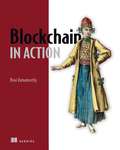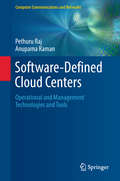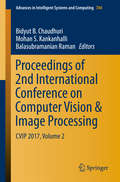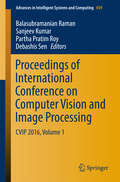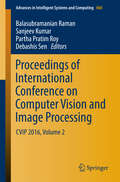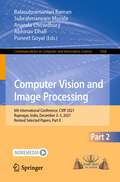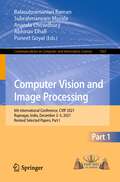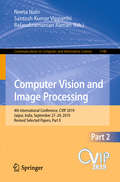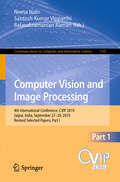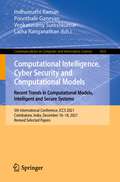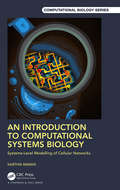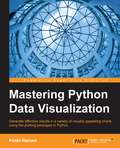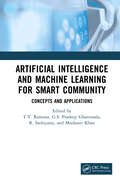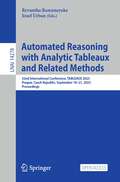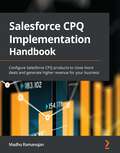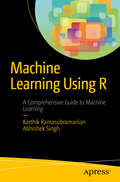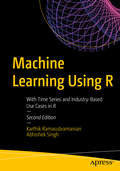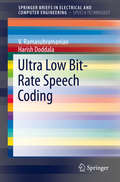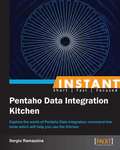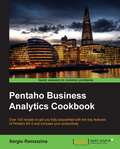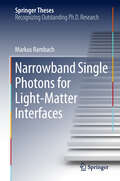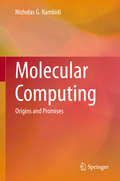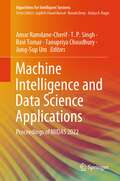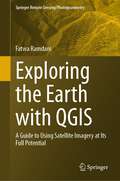- Table View
- List View
Blockchain in Action (In Action Ser.)
by Bina RamamurthyThere&’s a lot more to the blockchain than mining Bitcoin. This secure system for registering and verifying ownership and identity is perfect for supply chain logistics, health records, and other sensitive data management tasks. Blockchain in Action unlocks the full potential of this revolutionary technology, showing you how to build your own decentralized apps for secure applications including digital democracy, private auctions, and electronic record management.Summary There&’s a lot more to the blockchain than mining Bitcoin. This secure system for registering and verifying ownership and identity is perfect for supply chain logistics, health records, and other sensitive data management tasks. Blockchain in Action unlocks the full potential of this revolutionary technology, showing you how to build your own decentralized apps for secure applications including digital democracy, private auctions, and electronic record management. Purchase of the print book includes a free eBook in PDF, Kindle, and ePub formats from Manning Publications. About the technology Blockchain is more than just the tech behind Bitcoin—much more! Combining impenetrable security, decentralized transactions, and independently verifiable supply chains, blockchain applications have transformed currency, digital identity, and logistics. Platforms such as Ethereum and Hyperledger make it easy to get started by using familiar programming languages. About the book Blockchain in Action teaches you how to design and build blockchain-based decentralized apps, and is written in a clear, jargon-free style. First, you&’ll get an overview of how blockchain works. Next, you&’ll code your first smart contract using Ethereum and Solidity, adding a web interface, trust validation, and other features until your app is ready for deployment. The only thing you need to get started is standard hardware and open source software. What's inside Blockchain compared with other distributed systems Development in Solidity Identity, privacy, and security On-chain and off-chain data and operations About the reader For programmers who know JavaScript. About the author Bina Ramamurthy has thirty years of experience teaching distributed systems, data science, peer-to-peer networking, and blockchain. Table of Contents PART 1 - GETTING STARTED WITH BLOCKCHAIN PROGRAMMING 1 Blockchain basics 2 Smart contracts 3 Techniques for trust and integrity 4 From smart contracts to Dapps PART 2 - TECHNIQUES FOR END-TO-END DAPP DEVELOPMENT 5 Security and privacy 6 On-chain and off-chain data 7 Web3 and a channel Dapp 8 Going public with Infura PART 3 - A ROADMAP AND THE ROAD AHEAD 9 Tokenization of assets 10 Testing smart contracts 11 A roadmap to Dapp development 12 Blockchain: The Road ahead
Software-Defined Cloud Centers: Operational And Management Technologies And Tools (Computer Communications and Networks)
by Anupama Raman Pethuru RajThis practical text/reference provides an exhaustive guide to setting up and sustaining software-defined data centers (SDDCs). Each of the core elements and underlying technologies are explained in detail, often supported by real-world examples. The text illustrates how cloud integration, brokerage, and orchestration can ensure optimal performance and usage of data resources, and what steps are required to secure each component in a SDDC. The coverage also includes material on hybrid cloud concepts, cloud-based data analytics, cloud configuration, enterprise DevOps and code deployment tools, and cloud software engineering.Topics and features: highlights how technologies relating to cloud computing, IoT, blockchain, and AI are revolutionizing business transactions, operations, and analytics; introduces the concept of Cloud 2.0, in which software-defined computing, storage, and networking are applied to produce next-generation cloud centers; examines software-defined storage for storage virtualization, covering issues of cloud storage, storage tiering, and deduplication; discusses software-defined networking for network virtualization, focusing on techniques for network optimization in data centers; reviews the qualities and benefits of hybrid clouds, that bridge private and public cloud environments; investigates the security management of a software-defined data center, and proposes a framework for managing hybrid IT infrastructure components; describes the management of multi-cloud environments through automated tools, and cloud brokers that aim to simplify cloud access, use and composition; covers cloud orchestration for automating application integration, testing, infrastructure provisioning, software deployment, configuration, and delivery.This comprehensive work is an essential reference for all practitioners involved with software-defined data center technologies, hybrid clouds, cloud service management, cloud-based analytics, and cloud-based software engineering.
Proceedings of 2nd International Conference on Computer Vision & Image Processing: Cvip 2017, Volume 1 (Advances In Intelligent Systems And Computing #703)
by Balasubramanian Raman Mohan S. Kankanhalli Bidyut B. ChaudhuriThe book provides insights into the Second International Conference on Computer Vision & Image Processing (CVIP-2017) organized by Department of Computer Science and Engineering of Indian Institute of Technology Roorkee. The book presents technological progress and research outcomes in the area of image processing and computer vision. The topics covered in this book are image/video processing and analysis; image/video formation and display; image/video filtering, restoration, enhancement and super-resolution; image/video coding and transmission; image/video storage, retrieval and authentication; image/video quality; transform-based and multi-resolution image/video analysis; biological and perceptual models for image/video processing; machine learning in image/video analysis; probability and uncertainty handling for image/video processing; motion and tracking; segmentation and recognition; shape, structure and stereo.
Proceedings of International Conference on Computer Vision and Image Processing
by Balasubramanian Raman Sanjeev Kumar Partha Pratim Roy Debashis SenThe book is an edited volume that contains technical contributions in the field of computer vision and image processing presented at the First International Conference on Computer Vision and Image Processing (CVIP 2016). The contributions are thematically divided based on their relation to operations at the lower, middle and higher levels of vision systems, and their applications. The technical contributions in the areas of sensors, acquisition, visualization and enhancement are classified as related to low-level operations. The technical contributions in these areas discuss various modern topics such as reconfigurable image system architecture, Scheimpflug camera calibration, real-time autofocusing, climate visualization, tone mapping, super-resolution and image resizing. A reconfigurable architecture through non-uniformity correction for long-wave infra-red sensors is presented. A lens distortion model is proposed for calibration of cameras that work based on Scheimpflug principle. An algorithm to implement real-time autofocusing for thermal imagers is given and a novel visualization framework of cloud pattern formation estimating climate is also deliberated. In addition, an algorithm for tone mapping of high dynamic range images through local processing is presented. Content-aware image size reduction based on image energy computation and depth based image super-resolution is discussed as well. The technical contributions in the areas of segmentation and retrieval are classified as related to mid-level operations. The technical contributions in these areas discuss some state-of-the-art techniques such as non-rigid image registration, iterative image partitioning, egocentric object detection and video shot boundary detection. A low-complexity non-rigid image registration using feature-based diffeomorphic log-demons is proposed. A study of ancient stone images using iterative image partitioning is also presented. A semi-automatic object detection method for egocentric videos is given which is used to study object perception by infants. In addition, fusion of local and global features in a hierarchical architecture of video shot boundary detection is discussed as well. The technical contributions in the areas of classification and retrieval are categorized as related to high-level operations. The technical contributions in these areas discuss some state-of-the-art approaches such as extreme learning machines, and target, gesture and action recognition. A non-regularized state preserving extreme learning machine is presented for natural scene classification. An algorithm for human action recognition through dynamic frame warping based on depth cues is given. Target recognition in night vision through convolutional neural network is also presented. Use of convolutional neural network in detecting static hand gesture is also discussed. Finally, the technical contributions in the areas of surveillance, coding and data security, and biometrics and document processing are considered as applications of computer vision and image processing. The technical contributions in these areas discuss some contemporary applications. A few of them are a system for tackling blind curves, a quick reaction target acquisition and tracking system, an algorithm to detect for copy-move forgery based on circle block, a novel visual secret sharing scheme using affine cipher and image interleaving, a finger knuckle print recognition system based on wavelet and Gabor filtering, and a palmprint recognition based on minutiae quadruplets.
Proceedings of International Conference on Computer Vision and Image Processing
by Balasubramanian Raman Sanjeev Kumar Partha Pratim Roy Debashis SenThe book is an edited volume that contains technical contributions in the field of computer vision and image processing presented at the First International Conference on Computer Vision and Image Processing (CVIP 2016). The contributions are thematically divided based on their relation to operations at the lower, middle and higher levels of vision systems, and their applications. The technical contributions in the areas of sensors, acquisition, visualization and enhancement are classified as related to low-level operations. The technical contributions in these areas discuss various modern topics such as reconfigurable image system architecture, Scheimpflug camera calibration, real-time autofocusing, climate visualization, tone mapping, super-resolution and image resizing. A reconfigurable architecture through non-uniformity correction for long-wave infra-red sensors is presented. A lens distortion model is proposed for calibration of cameras that work based on Scheimpflug principle. An algorithm to implement real-time autofocusing for thermal imagers is given and a novel visualization framework of cloud pattern formation estimating climate is also deliberated. In addition, an algorithm for tone mapping of high dynamic range images through local processing is presented. Content-aware image size reduction based on image energy computation and depth based image super-resolution is discussed as well. The technical contributions in the areas of segmentation and retrieval are classified as related to mid-level operations. The technical contributions in these areas discuss some state-of-the-art techniques such as non-rigid image registration, iterative image partitioning, egocentric object detection and video shot boundary detection. A low-complexity non-rigid image registration using feature-based diffeomorphic log-demons is proposed. A study of ancient stone images using iterative image partitioning is also presented. A semi-automatic object detection method for egocentric videos is given which is used to study object perception by infants. In addition, fusion of local and global features in a hierarchical architecture of video shot boundary detection is discussed as well. The technical contributions in the areas of classification and retrieval are categorized as related to high-level operations. The technical contributions in these areas discuss some state-of-the-art approaches such as extreme learning machines, and target, gesture and action recognition. A non-regularized state preserving extreme learning machine is presented for natural scene classification. An algorithm for human action recognition through dynamic frame warping based on depth cues is given. Target recognition in night vision through convolutional neural network is also presented. Use of convolutional neural network in detecting static hand gesture is also discussed. Finally, the technical contributions in the areas of surveillance, coding and data security, and biometrics and document processing are considered as applications of computer vision and image processing. The technical contributions in these areas discuss some contemporary applications. A few of them are a system for tackling blind curves, a quick reaction target acquisition and tracking system, an algorithm to detect for copy-move forgery based on circle block, a novel visual secret sharing scheme using affine cipher and image interleaving, a finger knuckle print recognition system based on wavelet and Gabor filtering, and a palmprint recognition based on minutiae quadruplets.
Computer Vision and Image Processing: 6th International Conference, CVIP 2021, Rupnagar, India, December 3–5, 2021, Revised Selected Papers, Part II (Communications in Computer and Information Science #1568)
by Balasubramanian Raman Subrahmanyam Murala Ananda Chowdhury Abhinav Dhall Puneet GoyalThis two-volume set (CCIS 1567-1568) constitutes the refereed proceedings of the 6h International Conference on Computer Vision and Image Processing, CVIP 2021, held in Rupnagar, India, in December 2021. The 70 full papers and 20 short papers were carefully reviewed and selected from the 260 submissions. The papers present recent research on such topics as biometrics, forensics, content protection, image enhancement/super-resolution/restoration, motion and tracking, image or video retrieval, image, image/video processing for autonomous vehicles, video scene understanding, human-computer interaction, document image analysis, face, iris, emotion, sign language and gesture recognition, 3D image/video processing, action and event detection/recognition, medical image and video analysis, vision-based human GAIT analysis, remote sensing, and more.
Computer Vision and Image Processing: 6th International Conference, CVIP 2021, Rupnagar, India, December 3–5, 2021, Revised Selected Papers, Part I (Communications in Computer and Information Science #1567)
by Balasubramanian Raman Subrahmanyam Murala Ananda Chowdhury Abhinav Dhall Puneet GoyalThis two-volume set (CCIS 1567-1568) constitutes the refereed proceedings of the 6h International Conference on Computer Vision and Image Processing, CVIP 2021, held in Rupnagar, India, in December 2021. The 70 full papers and 20 short papers were carefully reviewed and selected from the 260 submissions. The papers present recent research on such topics as biometrics, forensics, content protection, image enhancement/super-resolution/restoration, motion and tracking, image or video retrieval, image, image/video processing for autonomous vehicles, video scene understanding, human-computer interaction, document image analysis, face, iris, emotion, sign language and gesture recognition, 3D image/video processing, action and event detection/recognition, medical image and video analysis, vision-based human GAIT analysis, remote sensing, and more.
Computer Vision and Image Processing: 4th International Conference, CVIP 2019, Jaipur, India, September 27–29, 2019, Revised Selected Papers, Part II (Communications in Computer and Information Science #1148)
by Balasubramanian Raman Neeta Nain Santosh Kumar VipparthiThis two-volume set (CCIS 1147, CCIS 1148) constitutes the refereed proceedings of the 4th International Conference on Computer Vision and Image Processing. held in Jaipur, India, in September 2019. The 73 full papers and 10 short papers were carefully reviewed and selected from 202 submissions. The papers are organized by the topical headings in two parts. Part I: Biometrics; Computer Forensic; Computer Vision; Dimension Reduction; Healthcare Information Systems; Image Processing; Image segmentation; Information Retrieval; Instance based learning; Machine Learning.Part II: Neural Network; Object Detection; Object Recognition; Online Handwriting Recognition; Optical Character Recognition; Security and Privacy; Unsupervised Clustering.
Computer Vision and Image Processing: 4th International Conference, CVIP 2019, Jaipur, India, September 27–29, 2019, Revised Selected Papers, Part I (Communications in Computer and Information Science #1147)
by Balasubramanian Raman Neeta Nain Santosh Kumar VipparthiThis two-volume set (CCIS 1147, CCIS 1148) constitutes the refereed proceedings of the 4th International Conference on Computer Vision and Image Processing. held in Jaipur, India, in September 2019. The 73 full papers and 10 short papers were carefully reviewed and selected from 202 submissions. The papers are organized according to the following topics: Part I: Biometrics; Computer Forensic; Computer Vision; Dimension Reduction; Healthcare Information Systems; Image Processing; Image segmentation; Information Retrieval; Instance based learning; Machine Learning.Part II: Neural Network; Object Detection; Object Recognition; Online Handwriting Recognition; Optical Character Recognition; Security and Privacy; Unsupervised Clustering.
Computational Intelligence, Cyber Security and Computational Models. Recent Trends in Computational Models, Intelligent and Secure Systems: 5th International Conference, ICC3 2021, Coimbatore, India, December 16–18, 2021, Revised Selected Papers (Communications in Computer and Information Science #1631)
by Indhumathi Raman Poonthalir Ganesan Venkatasamy Sureshkumar Latha RanganathanThis book constitutes the proceedings of the 5th International Conference, ICC3 2021, held in Coimbatore, India, during December 16–18, 2021. The 14 full papers included in this book were carefully reviewed and selected from 84 submissions. They were organized in topical sections as follows: computational intelligence; cyber security; and computational models.
An Introduction to Computational Systems Biology: Systems-Level Modelling of Cellular Networks (Chapman & Hall/CRC Computational Biology Series)
by Karthik Raman"This is a very comprehensive read that provides a solid base in computational biology. The book is structured in 4 parts and 14 chapters which cover all the way from the more basic concepts to advanced material, including the state-of-the-art methodologies in synthetic and systems biology. This is a bedside book for those researchers embarking to do investigation in computational biology and a great office companion for anyone working on systems and synthetic biology." -- Rodrigo Ledesma Amaro, Lecturer, Imperial College London "This is a fantastic book. It offers an elegant introduction to both classical and modern concepts in computational biology. To the uninitiated, it is a terrific first read, bringing alive the glory of the past and the promise of the future. To the interested, it handholds and offers a springboard to dive deep. To the practitioner, it serves as a valuable resource bringing together in a panoramic view many diverse streams that adorn the landscape." -- Narendra M. Dixit, Professor, Indian Institute of Science An Introduction to Computational Systems Biology: Systems-Level Modelling of Cellular Networks delivers a comprehensive and insightful account of applying mathematical modelling approaches to very large biological systems and networks—a fundamental aspect of computational systems biology. The book covers key modelling paradigms in detail, while at the same time retaining a simplicity that will appeal to those from less quantitative fields. Features A hands-on approach to modelling Covers a broad spectrum of modelling, from static networks to dynamic models and constraint-based models Thoughtful exercises to test and enable understanding of concepts State-of-the-art chapters on exciting new developments like community modelling and biological circuit design Emphasis on coding and software tools for systems biology This book is highly multi-disciplinary and will appeal to biologists, engineers, computer scientists, mathematicians and others.
Mastering Python Data Visualization
by Kirthi RamanGenerate effective results in a variety of visually appealing charts using the plotting packages in PythonAbout This BookExplore various tools and their strengths while building meaningful representations that can make it easier to understand dataPacked with computational methods and algorithms in diverse fields of scienceWritten in an easy-to-follow categorical style, this book discusses some niche techniques that will make your code easier to work with and reuseWho This Book Is ForIf you are a Python developer who performs data visualization and wants to develop existing knowledge about Python to build analytical results and produce some amazing visual display, then this book is for you. A basic knowledge level and understanding of Python libraries is assumed.What You Will LearnGather, cleanse, access, and map data to a visual frameworkRecognize which visualization method is applicable and learn best practices for data visualizationGet acquainted with reader-driven narratives and author-driven narratives and the principles of perceptionUnderstand why Python is an effective tool to be used for numerical computation much like MATLAB, and explore some interesting data structures that come with itExplore with various visualization choices how Python can be very useful in computation in the field of finance and statisticsGet to know why Python is the second choice after Java, and is used frequently in the field of machine learningCompare Python with other visualization approaches using Julia and a JavaScript-based framework such as D3.jsDiscover how Python can be used in conjunction with NoSQL such as Hive to produce results efficiently in a distributed environmentIn DetailPython has a handful of open source libraries for numerical computations involving optimization, linear algebra, integration, interpolation, and other special functions using array objects, machine learning, data mining, and plotting. Pandas have a productive environment for data analysis. These libraries have a specific purpose and play an important role in the research into diverse domains including economics, finance, biological sciences, social science, health care, and many more. The variety of tools and approaches available within Python community is stunning, and can bolster and enhance visual story experiences.This book offers practical guidance to help you on the journey to effective data visualization. Commencing with a chapter on the data framework, which explains the transformation of data into information and eventually knowledge, this book subsequently covers the complete visualization process using the most popular Python libraries with working examples. You will learn the usage of Numpy, Scipy, IPython, MatPlotLib, Pandas, Patsy, and Scikit-Learn with a focus on generating results that can be visualized in many different ways. Further chapters are aimed at not only showing advanced techniques such as interactive plotting; numerical, graphical linear, and non-linear regression; clustering and classification, but also in helping you understand the aesthetics and best practices of data visualization. The book concludes with interesting examples such as social networks, directed graph examples in real-life, data structures appropriate for these problems, and network analysis.By the end of this book, you will be able to effectively solve a broad set of data analysis problems.Style and approachThe approach of this book is not step by step, but rather categorical. The categories are based on fields such as bioinformatics, statistical and machine learning, financial computation, and linear algebra. This approach is beneficial for the community in many different fields of work and also helps you learn how one approach can make sense across many fields
Artificial Intelligence and Machine Learning for Smart Community: Concepts and Applications
by T. V. Ramana G. S. Pradeep Ghantasala R. Sathiyaraj Mudassir KhanIntelligent systems are technologically advanced machines that perceive and respond to the world around them. Artificial Intelligence and Machine Learning for Smart Community: Concepts and Applications presents the evolution, challenges, and limitations of the application of machine learning and artificial intelligence to intelligent systems and smart communities. Covers the core and fundamental aspects of artificial intelligence, machine learning, and computational algorithms in smart intelligent systems Discusses the integration of artificial intelligence with machine learning using mathematical modeling Elaborates concepts like supervised and unsupervised learning, and machine learning algorithms, such as linear regression, logistic regression, random forest, and performance evaluation matrices Introduces modern algorithms such as convolutional neural networks and support vector machines Presents case studies on smart healthcare, smart traffic management, smart buildings, autonomous vehicles, smart education, modern community, and smart machines Artificial Intelligence and Machine Learning for Smart Community: Concepts and Applications is primarily written for graduate students and academic researchers working in the fields of computer science and engineering, electrical engineering, and information technology. Seasonal Blurb: This reference text presents the most recent and advanced research on the application of artificial intelligence and machine learning on intelligent systems. It will discuss important topics such as business intelligence, reinforcement learning, supervised learning, and unsupervised learning in a comprehensive manner.
Automated Reasoning with Analytic Tableaux and Related Methods: 32nd International Conference, TABLEAUX 2023, Prague, Czech Republic, September 18–21, 2023, Proceedings (Lecture Notes in Computer Science #14278)
by Revantha Ramanayake Josef UrbanThis open access book constitutes the proceedings of the proceedings of the 32nd International Conference on Automated Reasoning with Analytic Tableaux and Related Methods, TABLEAUX 2023, held in Prague, Czech Republic, during September 18-21, 2023. The 20 full papers and 5 short papers included in this book together with 5 abstracts of invited talks were carefully reviewed and selected from 43 submissions. They present research on all aspects of the mechanization of reasoning with tableaux and related methods. The papers are organized in the following topical sections: tableau calculi; sequent calculi; theorem proving; non-wellfounded proofs; modal logics; linear logic and MV-algebras; separation logic; and first-order logics.
Rough Sets: International Joint Conference, IJCRS 2021, Bratislava, Slovakia, September 19–24, 2021, Proceedings (Lecture Notes in Computer Science #12872)
by Sheela Ramanna Chris Cornelis Davide CiucciThe volume LNAI 12872 constitutes the proceedings of the International Joint Conference on Rough Sets, IJCRS 2021, Bratislava, Slovak Republic, in September 2021. The conference was held as a hybrid event due to the COVID-19 pandemic. The 13 full paper and 7 short papers presented were carefully reviewed and selected from 26 submissions, along with 5 invited papers. The papers are grouped in the following topical sections: core rough set models and methods, related methods and hybridization, and areas of applications.
Salesforce CPQ Implementation Handbook: Configure Salesforce CPQ products to close more deals and generate higher revenue for your business
by Madhu RamanujanThis book is for business analysts, functional consultants, sales managers, Salesforce architects, and those looking to gain Salesforce CPQ certification. Working knowledge of the Salesforce ecosystem is recommended to get the most out of this book.
Machine Learning Using R
by Karthik Ramasubramanian Abhishek SinghExamine the latest technological advancements in building a scalable machine learning model with Big Data using R. This book shows you how to work with a machine learning algorithm and use it to build a ML model from raw data. All practical demonstrations will be explored in R, a powerful programming language and software environment for statistical computing and graphics. The various packages and methods available in R will be used to explain the topics. For every machine learning algorithm covered in this book, a 3-D approach of theory, case-study and practice will be given. And where appropriate, the mathematics will be explained through visualization in R. All the images are available in color and hi-res as part of the code download. This new paradigm of teaching machine learning will bring about a radical change in perception for many of those who think this subject is difficult to learn. Though theory sometimes looks difficult, especially when there is heavy mathematics involved, the seamless flow from the theoretical aspects to example-driven learning provided in this book makes it easy for someone to connect the dots. . What You'll Learn Use the model building process flow Apply theoretical aspects of machine learning Review industry-based cae studies Understand ML algorithms using R Build machine learning models using Apache Hadoop and Spark Who This Book is For Data scientists, data science professionals and researchers in academia who want to understand the nuances of machine learning approaches/algorithms along with ways to see them in practice using R. The book will also benefit the readers who want to understand the technology behind implementing a scalable machine learning model using Apache Hadoop, Hive, Pig and Spark.
Machine Learning Using R
by Karthik Ramasubramanian Abhishek SinghExamine the latest technological advancements in building a scalable machine-learning model with big data using R. This second edition shows you how to work with a machine-learning algorithm and use it to build a ML model from raw data. You will see how to use R programming with TensorFlow, thus avoiding the effort of learning Python if you are only comfortable with R.As in the first edition, the authors have kept the fine balance of theory and application of machine learning through various real-world use-cases which gives you a comprehensive collection of topics in machine learning. New chapters in this edition cover time series models and deep learning.What You'll Learn Understand machine learning algorithms using RMaster the process of building machine-learning models Cover the theoretical foundations of machine-learning algorithmsSee industry focused real-world use casesTackle time series modeling in RApply deep learning using Keras and TensorFlow in RWho This Book is ForData scientists, data science professionals, and researchers in academia who want to understand the nuances of machine-learning approaches/algorithms in practice using R.
Ultra Low Bit-Rate Speech Coding
by V. Ramasubramanian Harish Doddala"Ultra Low Bit-Rate Speech Coding" focuses on the specialized topic of speech coding at very low bit-rates of 1 Kbits/sec and less, particularly at the lower ends of this range, down to 100 bps. The authors set forth the fundamental results and trends that form the basis for such ultra low bit-rates to be viable and provide a comprehensive overview of various techniques and systems in literature to date, with particular attention to their work in the paradigm of unit-selection based segment quantization. The book is for research students, academic faculty and researchers, and industry practitioners in the areas of speech processing and speech coding.
Instant Pentaho Data Integration Kitchen
by Sergio RamazzinaFilled with practical, step-by-step instructions and clear explanations for the most important and useful tasks. A practical guide with easy-to-follow recipes helping developers to quickly and effectively collect data from disparate sources such as databases, files, and applications, and turn the data into a unified format that is accessible and relevant to end users.Any IT professional working on PDI and is a valid support for either learning how to use the command line tools efficiently or for going deeper on some aspects of the command line tools to help you work better.
Pentaho Business Analytics Cookbook
by Sergio RamazzinaThis practical guide contains a wide variety of recipes, taking you through all the topics you need to quickly familiarize yourself with Pentaho and extend your Pentaho skillset. If you are involved in daily activities using Pentaho Business Analytics platform, this is the book for you. It is a good companion to get you quickly acquainted with everything you need to increase your productivity with the platform. We assume basic familiarity with Pentaho, data warehouse design and SQL, HTML, and XML.
Narrowband Single Photons for Light-Matter Interfaces (Springer Theses)
by Markus RambachThis book provides a step-by-step guide on how to construct a narrowband single photon source for the integration with atom-based memory systems. It combines the necessary theoretical background with crucial experimental methods and characterisations to form a complete handbook for readers at all academic levels. The future implementation of large quantum networks will require the hybridisation of photonic qubits for communication with quantum memories in the context of information storage. Such an interface requires carefully tailored single photons to ensure compatibility with the chosen memory. The source itself is remarkable for a number of reasons, including being the spectrally narrowest and brightest source of its kind; in addition, it offers a novel technique for frequency stabilisation in an optical cavity, together with exceptional portability. Starting with a thorough analysis of the current literature, this book derives the essential parameters needed to design the source, describes its individual components in detail, and closes with the characterisation of a single photon source.
Molecular Computing
by Nicholas G. RambidiThe question whether molecular primitives can prove to be real alternatives to contemporary semiconductor means or effective supplements extending greatly possibilities of information technologies is addressed. Molecular primitives and circuitry for information processing devices are also discussed. Investigations in molecular based computing devices were initiated in the early 1970s in the hopes for an increase in the integration level and processing speed. Real progress proved unfeasible into the 1980´s. However, recently, important and promising results were achieved. The elaboration of operational 160-kilobit molecular electronic memory patterned 1011 bits per square centimeter in the end of 90´s were the first timid steps of information processing further development. Subsequent advances beyond these developments are presented and discussed. This work provides useful knowledge to anyone working in molecular based information processing.
Machine Intelligence and Data Science Applications: Proceedings of MIDAS 2022 (Algorithms for Intelligent Systems)
by Amar Ramdane-Cherif T. P. Singh Ravi Tomar Tanupriya Choudhury Jung-Sup UmThis book is a compilation of peer-reviewed papers presented at the International Conference on Machine Intelligence and Data Science Applications (MIDAS 2022), held on October 28 and 29, 2022, at the University of Versailles—Paris-Saclay, France. The book covers applications in various fields like data science, machine intelligence, image processing, natural language processing, computer vision, sentiment analysis, and speech and gesture analysis. It also includes interdisciplinary applications like legal, healthcare, smart society, cyber-physical system, and smart agriculture. The book is a good reference for computer science engineers, lecturers/researchers in the machine intelligence discipline, and engineering graduates.
Exploring the Earth with QGIS: A Guide to Using Satellite Imagery at Its Full Potential (Springer Remote Sensing/Photogrammetry)
by Fatwa RamdaniWith the rapid advancements in satellite technology, earth remote sensing has become an indispensable tool for a wide range of applications, from environmental monitoring to disaster management. However, the vast amount of data generated by these satellites can be overwhelming for many researchers and practitioners who lack the necessary skills and tools to process and analyze it. This is where QGIS comes in. QGIS is a powerful, open-source Geographic Information System (GIS) software that has been extensively used in the field of earth remote sensing. It provides a user-friendly platform for processing, analyzing, and visualizing satellite imagery, enabling users to unlock the full potential of earth remote sensing data. The purpose of this book is to help researchers and practitioners who lack the necessary skills and tools to process and analyze satellite imagery using QGIS. There are several books that cover the use of QGIS for earth remote sensing, but most of them are either too technical or too general. This book fills this gap by providing a comprehensive and user-friendly guide to using QGIS for earth remote sensing applications. It includes a range of real-world case studies that demonstrate the power and versatility of QGIS for solving complex problems in earth remote sensing. This will provide readers with practical examples of how to use QGIS for earth remote sensing and inspire them to explore new applications and possibilities. The book is intended for GIS professionals, students (undergraduate and graduate), and researchers who are interested in using QGIS for earth remote sensing applications. It will be particularly useful for those who are new to QGIS or who want to expand their knowledge of the software for remote sensing purposes.
